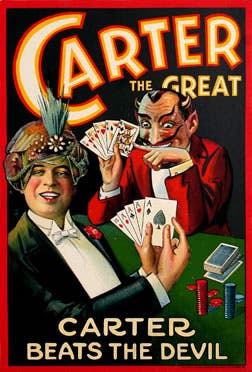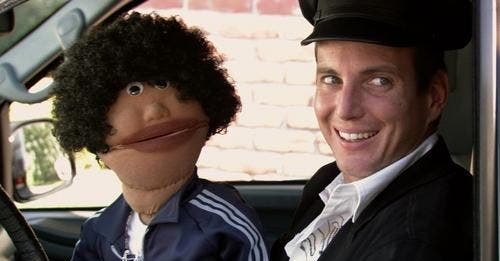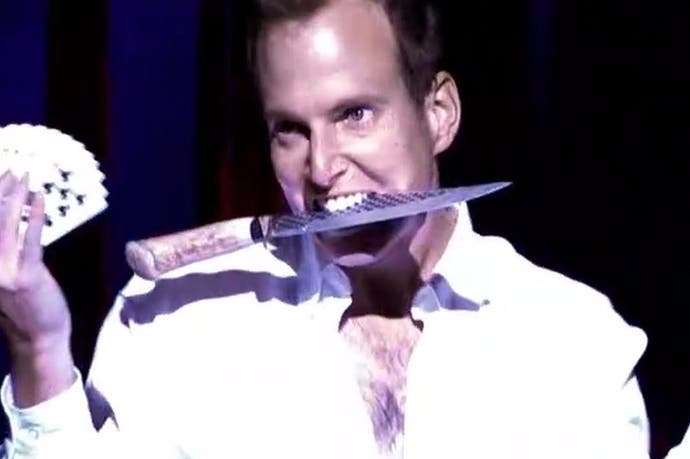"A compelling, impossible thing": Where magic and video games converge
"It's an illusion, Michael."
For something to be extraordinary, it must emerge from the ordinary. Magicians know this, which is why they work their greatest tricks with coins and playing cards and the linty jumble of everyday things that their marks - both their audiences and, in a manner of speaking, their victims - tend to keep in their pockets. Magic perks you up, because it reminds you that there is strange pleasure to be found where you least expect it to be lurking. Magicians make the world new, and to do this, maybe the world must first seem a little old and tatty.
This is also why a lot of magicians tend to stay away from smartphones. The problem here is not that your phone has a limited capacity for magic. It's that, to all intents, it is magic already. Matthew Leatherbarrow, a magician I met in London a few weeks back, nods rather seriously when we discuss these things. I suspect Leatherbarrow is not a frowner by nature, but this is a special exception. "There's this idea in magic that doing magic with extraordinary objects is a losing game," he says. Then, to illustrate his point and lighten the mood, he picks a fork up from the table - we're sitting in a Patisserie Valerie in Soho, near where Leatherbarrow works as a software designer - and he briskly bends it in half and then passes it to me. By the time the fork touches my hand, of course, it is like it has never been bent at all.
Leatherbarrow, who is 29 and boyish, a teen wizard with his floppy black hair and his specs, has spent a lot of time thinking about this problem. He is, after all, a magician who has released Magic Kit, an app filled with magic tricks that absolutely require your smartphone in order to work - a high-wire act that he pulls off with easy skill. Perhaps it goes deeper, though. The need for the extraordinary to emerge from the ordinary may also explain why, magic app completed and looking to design Drop Shadow, his first smartphone video game, Leatherbarrow turned to the most boring thing he could think of for inspiration: his morning commute across London on the tube. It makes sense. The more time I spend with Leatherbarrow, the more forks he bends and spectral keys he brings to life simply by pointing at them while maintaining a funny expression, the more I start to realise that magic and games can be two sides of the same coin. A bright coin, glinting as it dances up and down the knuckles, daring you to spot the effort, daring you to spot the trick.

In a way, Leatherbarrow made Drop Shadow for himself. He certainly made it to meet some very specific criteria. He wanted a game that offered the clear goals and maddening one-more-go appeal of Impossible Road, a twitchy hi-score masterclass in which you steer a negative-space ping-pong ball down an endless curling ribbon of track. He also wanted to be able to play this on a packed tube train, though - a situation that would leave him single-handed as he used the other one to stop him from pitching forward into somebody's lap. Impossible Road requires two thumbs. His game would work with only one.
There was yet another design objective, although it was more of an in-joke, really. "I used to laugh with colleagues that I'd invent a game where the principal design goal was its name," says Leatherbarrow, a little self-consciously. "I guess hearing that would make any game designer in the world kill themselves."
After a while spent tinkering with Unity and Photoshop, Leatherbarrow's game started to fall into place. And fall is the correct turn of phrase most probably, since Drop Shadow is a game about guiding a fragile bubble - it's actually a shadow without an object to cast it - as it plummets through an endless expanse of white screen. While you're doing this, you steer around items that make your shadow weaker and into items that make it stronger. Don't let your shadow drop, get it? After a false start where Leatherbarrow briefly envisioned the game as a horizontal affair, the whole design tidied itself up fairly quickly. If you ask me it's a treat to play, but I wonder: did it meet Leatherbarrow's own expectations? "What I can say," he laughs, "is that I don't play Impossible Road on the tube anymore, and I do play my own game. If other people play it too and get some value out of it, all the better."
Drop Shadow is not necessarily the sort of game you would imagine a magician making - although I really love magicians and I still struggle to think what that game might be. Is that the point though? What matters to Leatherbarrow is that the compulsion to create a game, and the attendant process of working out how to do it, is almost exactly the same as the compulsion to make a new trick.

Magic didn't shape the game's conception, then, but Leatherbarrow's knowledge of magic certainly helped him complete it. As an example, Leatherbarrow tells me about the hardest part of the design challenge on Drop Shadow: the in-game icons. "I fret about magic," he says. "I fret about a trick. And with the game I kept thinking: I have these icons that give you shadow and take it away. Okay: what sort of icon means more shadow? It's just an abstract concept. I played around with ridiculous icons before settling on a simple plus and a minus. That doesn't mean more shadow either, but in this precise context it does."
Leatherbarrow shrugs. There's a sense he's still not entirely satisfied with the solution, but he accepts that it is the solution all the same. Years of thinking about audiences, about marks, about what they will accept and what they won't, has given him an innate sense for the instant that a matter has been decided.
And the audience always has the deciding vote. This is the secret message hidden in great magic, and it's a message that transfers across very well to the world of games. In Carter Beats the Devil, Glen David Gold's absolutely wonderful novel of magic, emotional reawakening and complex decency, the eponymous Carter has a trick he is enormously satisfied with. He runs his finger over a silver dollar, and the minting location on the coin changes. San Francisco becomes Denver: ta da! Except: not ta da. Not ta da at all. Almost nobody Carter shows the trick to can spot the actual magic when it occurs. A sleight is only magic the moment somebody is there to bear witness. A peculiar sweet spot to hit, that one: ideally you need a person to understand that something has happened, but you don't want them to understand exactly what it was.
I've always loved magic, and I've always loved video games, but it's taken 36 years, and meeting a man like Leatherbarrow who moves between the both worlds, to truly see how similar they are. Here's Leatherbarrow on technology, for example, discussing the impact of new gadgets like the iPhone on magic tricks: "It's always additive," he says. "Magic tends to move in waves. You know, a new technology will be available, and it will be brought into a new set of tricks, and then it will stagnate for a while and then a new invention will come out, a new bit of technology, a new idea. But you will see them repeated over and over again across a broad set of tricks. That goes from new tricks today to if you go back in time, to the creation of those core moves."

Core moves! It turns out that the genepool of magic is as limited as the genepool of games, with its shooting, its block-pushing, its racing to the finish line. It's no wonder that The Royal Road to Card Magic, a legendary book that provides a brilliant introduction to basic trickery, kicks off by listing a few essential techniques - forces, palms, funny shuffles - that most of the illusions in the rest of the text then build upon. "There's one school of thought that says there's only five types of illusion: appearance, transposition, reappearance, things like that," says Leatherbarrow. "And then within coin magic there's a handful of moves, quite a few, maybe 30 to 50 moves, but that's still fairly limited." As with games, then, genuinely new ideas are rare in magic - and highly prized as a result. But that's not necessarily a bad thing. This state of affairs fosters ingenuity, as brilliant people learn to recombine seemingly tired elements in surprising new ways. A certain economy, a certain enforced focus, has kept magic dynamic and scrappy.
There is a wider point here, too, one that cuts to the heart of both games and magic, and it comes down to the the way that an illusion itself is created - or rather, the matter of pinpointing the moment where the magic truly occurs. "This is the other side of it, the other side of illusion-building once you put aside the basic parts," Leatherbarrow explains. "[With the bendy fork,] the illusion isn't what I did with the fork itself. What I did was just a series of simple moves. The illusion is when you tell your friends that this guy bent a fork and then it hadn't bent. You'll probably add details to it, some of which almost certainly didn't occur. You'll describe the beads of sweat as I worked, you'll describe seeing the fork springing back to its original shape. And that's really where the magic happens - in the mind and not in the artifact itself.
"With games there's definitely an element of this," Leatherbarrow continues. "You have to surrender yourself. With Assassin's Creed, especially the more recent ones, they're so in your face with their mechanics, with their familiar ideas, Unity particularly, that you kind of have to take a leap of faith with it. You have to make the story yourself. Minecraft is a really good example of that happening too. The game is what you bring to it as an audience. Magic hinges on that entirely, even when it isn't as participatory. That ability to allow people to project, onto a simple demonstration, something much more complex. That's really where it all happens and it feels true for games. You have to surrender to it."
The question, then, is: if video games are like magic tricks - if they're like magic tricks as truly as they're like cinema, music, literature, architecture, and any other cultural artifact that rubs up against this magpie medium and are endlessly co-opted in wonky treatise about the form - what kind of magic tricks are they? The search for an answer, I think, comes down to a central division in magic, a line that separates illusions into two basic types, sleights of hand and self-working magic.
A sleight involves dexterity and training and the clever - often speedy, generally concealed - manipulation of objects. Close-up magic, with its coins and its cards, is classic sleight territory, and I think Leatherbarrow's work with the bendy fork counts as a sleight too.

Self-working tricks are different, although they may often involve a degree of sleight of hand anyway. Happily, Leatherbarrow's something of an expert here. He designs and sells self-working tricks in his spare time; he considers himself an inventor as much as a magician, because he prefers to create illusions rather than perform them. It was self-working tricks that first drew him into magic in the first place, at a school talent show when a friend - whose parents were proper jobbing magicians, living their lives out of trunks with false bases and heading to work each day with doves stuffed down their sleeves - performed a trick that involved throwing a handkerchief in the air and watching as it transformed into a wand.
If the fork that unbends itself is a sleight, the handkerchief that becomes a wand is a self-working trick. (I won't spoil the illusion other than to say that it is gadget-based.) Video games? If modern video games rely on the antic recombination of simple pieces as sleights do, they are also filled with self-working tricks these days - complex devices that cast the player as the equivalent of the audience member plucked from the stalls, as the active witness guided through machinery that creates a specific effect, hiding the moments where the gears grind or where a glimpse into the deeper workings might be possible.
What's Uncharted, for example, if not a giant self-working trick? It requires you to bumble your way through each level, certainly, but once you're moving it's adept at guiding your eye towards the details that matter and over the trigger points that set the next piece of artifice in motion. It's controlled, like a self-working trick, and, in terms of success, it also comes down to the performance - the designer's, crucially, rather than the player's. Uncharted, with its collapsing skyscrapers, its silent mountain guides, its boss fights that unfold along the length of a speeding train and even follow the carriages once they've jumped the tracks, depends upon the abilities of its technicians and artists to sell the reality of the impossible adventure that you're experiencing.

Crucially, it doesn't really ruin anything if you realise this. In the old days, magicians would refer to the people they brought up on stage as marks, due to the fact that their associates would wander around the circus or the theatre where they were performing and, on finding a credulous, easily-suggestible sort of person, surreptitiously mark them with chalk for easy identification later on. These days, when we know about marks, when we have both a ready eagerness to understand how things work and the opportunity to find it out after a few minutes on Google, the terminology has evolved in interesting ways. These days, a magician's audience is likely to contain smarks, or smart-marks, a neologism that originated, apparently, in professional wrestling. Smarks know they're being tricked, but they can't help but believe in the illusion anyway, because it's just so romantic, so beguiling, so satisfying to do so. They appreciate things on a higher level, because any cognitive discord is acknowledged but then temporarily set aside.
In video games, we're all smarks.
Smarks are also a reminder that, while lots of kids see magic shows as children, the ones who eventually turn out to be magicians themselves react a little differently to everyone else. It comes down to a subtle rebalancing of that peculiar superpositioning that magic requires: that you believe in the splendour of what you've just witnessed, but you also wonder how it might have been made to happen. A technician's skepticism and an artist's - or an audience's - delight are allowed to coexist without touching in the magician's mind. I think the same is probably true of the kids who go onto be game designers.
"It's funny," says Leatherbarrow when I ask him how this sort of thing informs his position within the magical landscape. "It's only quite recently that I've, well, come out as a magician." He laughs. "In a sense. It's always been there and anybody who knows me would know it eventually, but, when I first met you, I explained that I'm a developer and a magician, and it's the first time I ever offered that as a way of badging myself. In the past I always felt like a bit of a pretender as I didn't have a regular gig on a stage. I'm not The Great anybody. But you know, I do invent tricks, I perform tricks, and I think that allows me to class myself as a magician. It's been kind of liberating to be able to say that. In meetings now at my day job, often I'll end up using elements of staging, of misdirection, elements of the sum total of the product being more than the parts of it. That's so fundamental to so many things that I do. It feels like cheating to not tell people I'm a magician. In a meeting if people found that out independently they'd be: is this whole thing one big manipulation? Inevitably you do use the skills you learn as a magician in general conversation too."
So is being a magician a way of life? "I think so," Leatherbarrow replies. "If you spend enough time viewing things through a slightly different lens, which I have to do, that lens becomes sort of fixed. For better off or worse, you start to view the entire world like that, you start to deconstruct things. You start to think of how it's made, and what people are trying to achieve and what they get out of it. All of those things are part of magic. They're all part of how I make my tricks."

This sounds exhausting. Luckily, it gets easier with time - at least some of it does. "One of the most challenging aspects of creating magic and performing magic is fooling yourself," says Leatherbarrow. "Fooling yourself in the right way. You can fool yourself in the wrong way where you don't look at the right thing at the right time and you still think you're doing a great trick. But fooling yourself in the right way, trying to appreciate an illusion from a spectator's point of view? That is probably impossible, but you will generate better illusions if you can try to do that all the same. There are some illusions where you get giddy, where you're like: this is so good it's fooling me. This is like magic to my eyes!" When this happens, it's the most precious thing in the world.
Towards the end of our conversation, I ask Leatherbarrow about something he mentioned to me in an email - that he finds creating tricks and creating games to be a draining process. Ever since I read this, I've wanted to understand why.
Leatherbarrow laughs. "A really good story to tell on that side is that I have actually invented a trick I have never shown anyone," he says. "Not outside of my immediate family. I'm going to leave it to the world when I'm gone. It's my favourite piece of illusion. I actually adore it.
"But! It was kind of agonising to come up with," he continues. "I had these core ideas, this kind of mechanic if you like, this simple way of doing something. I knew it could be great, but it just wasn't. I knew it had to be presented in a certain way. The mechanic was fine, I knew it was going to work, but it just didn't flow, it wasn't compelling. I would have nights after nights basically running over the script, running over the nuances of every single world in the script. Every single word in the script I deliver for that script is planned out. Every single word matters entirely for it to work. I don't do that for every trick. I can't. It's that thing of trying to understand how this looks to an outsider, trying to create a compelling, impossible thing, and it not being quite right. How do I make it right?
"Any problem you're trying to solve, once it's in your mind, it won't go away until you fix it." Leatherbarrow pauses and smiles. "And I did solve it," he says at last. "Eventually."
If you're interested in reading more about Matthew Leatherbarrow, he blogs at Illusionary.org.

